The original was suppose to be, then it got heavier, the Bradley was also.Just one note - I don't think the CV90 is amphibious. It will have to wait with the Leos for the pontoons to show up.
You are using an out of date browser. It may not display this or other websites correctly.
You should upgrade or use an alternative browser.
You should upgrade or use an alternative browser.
Infantry Vehicles
- Thread starter KevinB
- Start date
- Reaction score
- 8,635
- Points
- 1,160
So just another couple of boats that sank in the desert?The original was suppose to be, then it got heavier, the Bradley was also.
Blackadder1916
Army.ca Fixture
- Reaction score
- 2,887
- Points
- 1,160
if you can't swim, you sink and (hopefully) are able to drive out.
GK .Dundas
Army.ca Veteran
- Reaction score
- 1,735
- Points
- 960
The look on the drivers face is priceless.if you can't swim, you sink and (hopefully) are able to drive out.
GR66
Army.ca Veteran
- Reaction score
- 4,346
- Points
- 1,160
Yeah....as the water pouring in splashes on him!The look on the drivers face is priceless.
- Reaction score
- 8,635
- Points
- 1,160
Yeah....as the water pouring in splashes on him!
An awful lot of penetrations with an awful lot of rubber gaskets.....I wonder if they swapped them for Teflon? They last longer.
But what do you do about the turret ring?
- Reaction score
- 22,603
- Points
- 1,260
The Bradley Amphibious idea had been abandoned shortly after adoption.So just another couple of boats that sank in the desert?
If you followed the trials and congressional reports back then, the amphibious ability was marginal in perfect conditions. If the gunner moved the turret (let alone fired) off a few degrees from center it would start to list and take on water and then wouldn’t be on top of the water, but below.
As well the original M2 armor was vulnerable to 14.5mm fire, and so it was increased - which torpedoed any possibility of it conducting any thing resembling amphibious ops.
Then more armor was added to the sides - which got rid of the idiotic M231 Firing Port weapons and the trim vane up front was removed and additional armor to the front glacis plates was added.
———————-
Very few Amphib systems are resilient to 7.62x54R APIT from a PKM.
Let alone larger systems.
That round is my baseline minimum of an armored vehicle.
Anything less just run a soft skin and pray.
OldSolduer
Army.ca Relic
- Reaction score
- 16,409
- Points
- 1,260
Yes its neat to see this BUT it would all depend on the river bed and what kind of dirt is there would it not? I am pretty certain the Manitoba gumbo might defeat this.if you can't swim, you sink and (hopefully) are able to drive out.
And how about the prep time per tank?
What's the recovery plan if a tank conks out halfway in the river? Are there safety divers in the river?
- Reaction score
- 22,603
- Points
- 1,260
Let’s face it. In combat, for streams and rivers that can’t be forded by driving across you are realistically left with two options to cross:
1) bulldoze a metric butt ton of fill into it.
2) bridge it.
Depending on the depth, width and current one will likely be more practical than the other.
Now that doesn’t mean there is no roles for the amphibian types - I just don’t see them as a very viable combat option
I think the Argo and BV types are fantastic for certain missions, both domestically, and for non direct combat roles operationally.
1) bulldoze a metric butt ton of fill into it.
2) bridge it.
Depending on the depth, width and current one will likely be more practical than the other.
Now that doesn’t mean there is no roles for the amphibian types - I just don’t see them as a very viable combat option
I think the Argo and BV types are fantastic for certain missions, both domestically, and for non direct combat roles operationally.
daftandbarmy
Army.ca Dinosaur
- Reaction score
- 34,288
- Points
- 1,160
Let’s face it. In combat, for streams and rivers that can’t be forded by driving across you are realistically left with two options to cross:
1) bulldoze a metric butt ton of fill into it.
2) bridge it.
Depending on the depth, width and current one will likely be more practical than the other.
Now that doesn’t mean there is no roles for the amphibian types - I just don’t see them as a very viable combat option
I think the Argo and BV types are fantastic for certain missions, both domestically, and for non direct combat roles operationally.
And the
- Reaction score
- 22,603
- Points
- 1,260
Well regardless they are the ones either pushing fill, emplacing/erecting whatever type of bridge, or both…And theJoy KillersEngineers will let you know if you're good to go, or not
Doesn’t really appear to be a very safe job either - so I’m happy to watch from afar.
- Reaction score
- 29,280
- Points
- 1,090
A Bailey panel weighs 570 pounds, and is a six person load.
Building Bailey bridges by hand is one of the most enjoyable things I ever did in the military. In retrospect.
Building Bailey bridges by hand is one of the most enjoyable things I ever did in the military. In retrospect.
OldSolduer
Army.ca Relic
- Reaction score
- 16,409
- Points
- 1,260
As Elliot Gould said in "A Bridge Too Far"A Bailey panel weighs 570 pounds, and is a six person load.
Building Bailey bridges by hand is one of the most enjoyable things I ever did in the military. In retrospect.
Bailey crap.....
- Reaction score
- 22,603
- Points
- 1,260
I’ve watched a few Engineering events over the years…. Mostly I have thought what it would be like to by a Machine Gunner or Enemy FOO watching them muck around with the bridging.A Bailey panel weighs 570 pounds, and is a six person load.
Building Bailey bridges by hand is one of the most enjoyable things I ever did in the military. In retrospect.
OldSolduer
Army.ca Relic
- Reaction score
- 16,409
- Points
- 1,260
Good point but I think building one of these is done well out of contact or sight of the enemy. With all the drones etc surveilling the battlefield an op of this nature would be hard to hide.I’ve watched a few Engineering events over the years…. Mostly I have thought what it would be like to by a Machine Gunner or Enemy FOO watching them muck around with the bridging.
- Reaction score
- 367
- Points
- 780
Hmmmm, did the Germans know something- origional Marder proposal long time ago never considered amphib or snorkle ops. Just sayin'The Bradley Amphibious idea had been abandoned shortly after adoption.
If you followed the trials and congressional reports back then, the amphibious ability was marginal in perfect conditions. If the gunner moved the turret (let alone fired) off a few degrees from center it would start to list and take on water and then wouldn’t be on top of the water, but below.
As well the original M2 armor was vulnerable to 14.5mm fire, and so it was increased - which torpedoed any possibility of it conducting any thing resembling amphibious ops.
Then more armor was added to the sides - which got rid of the idiotic M231 Firing Port weapons and the trim vane up front was removed and additional armor to the front glacis plates was added.
———————-
Very few Amphib systems are resilient to 7.62x54R APIT from a PKM.
Let alone larger systems.
That round is my baseline minimum of an armored vehicle.
Anything less just run a soft skin and pray.
- Reaction score
- 8,635
- Points
- 1,160
Hmmmm, did the Germans know something- origional Marder proposal long time ago never considered amphib or snorkle ops. Just sayin'
Germany's WW2.
Drive over bridges to get to Russia and France. Retreat back to Germany and blow bridges.
Not much requirement to learn how to swim there.
And they gave up on swimming the Channel.
- Reaction score
- 8,635
- Points
- 1,160
Despite the reflex British crack at the Germans even the Germans anticipated water crossings. And used amphibious vehicles.
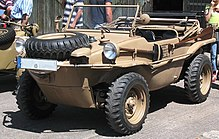
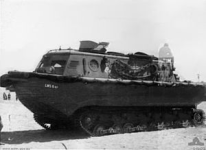
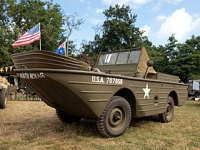

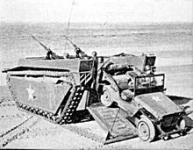
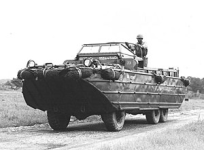
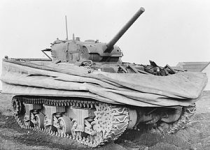
There was a demonstrable need to cross water obstacles before the bridging teams showed up. Often cobbled together by the Engineers that were tasked with getting troops across the water obstacles.
As for administrative moves....
How many troops went to war like this?
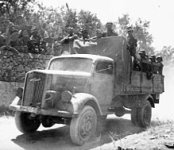
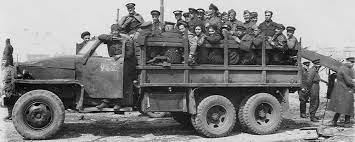
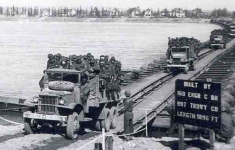
Not every movement is done in the face of the enemy. In fact most movement is administrative, and out of sight of the enemy. For the engineers that is probably the preferred solution.
I'm guessing that the guys building the bridges and driving the DUKWs and Terrapins and LVTs would have much preferred if the infantry and the cavalry and the artillery could have got themselves to the other side.
The infantry only had to cross the water once and move away from the target.
The engineers had to stay on the target either with the bridge or constantly crossing and recrossing the same body of water and using the same ramps.

The Volkswagen Schwimmwagen (literally "swimming car") was a four-wheel drive amphibious vehicle, used extensively by German ground forces during the Second World War. The Schwimmwagen is the most-produced amphibious car in history.[1]
Prototyped as the Type 128, it entered full-scale production as the Type 166 in 1941 for the Wehrmacht.

Landwasserschlepper (LWS) was an unarmed amphibious tractor produced in Germany during World War II.
...
Ordered by the Heereswaffenamt in 1935 for use by German Army engineers, the Landwasserschlepper (or LWS) was intended as a lightweight river tug with some capacity to operate on land.[1][2][3]
Intended to aid river crossing and bridging operations....
Due to protracted development, the Landwasserschlepper did not enter regular service until 1942 and, though it proved useful in both Eastern Front and North Africa campaign, it was produced in only small numbers. In 1944 a completely new design was introduced, the LWS II. This vehicle was based on a Panzer IV tank chassis and featured a small raised armored driver's cabin and a flat rear deck with four fold-down intake and exhaust stacks.[4]
Landwasserschlepper remained operational until the end of the war in May 1945.[1][2]

The Ford GPA "Seep" (Government 'P' Amphibious, where 'P' stood for its 80-inch wheelbase), with supply catalog number G504, was an amphibious version of the World War II Ford GPW jeep.
Design features of the much larger and successful DUKW amphibious 21⁄2-ton truck were used on the GPA, but unlike these and the jeep, the 'seep' was not a successful design. It was considered too slow and heavy on land, and lacked sufficient seagoing abilities in open water, due mainly to its low freeboard.[1]
The Soviet Union received roughly half of the total GPA production under Lend Lease, and were sufficiently satisfied with its ability to cross calmer inland waters, that they produced a copy, the GAZ-46.

The Terrapin (officially 4-ton amphibian) was a British-manufactured amphibious transport vehicle of the Second World War. It was first used in 1944 at Antwerp during the Battle of the Scheldt.
Terrapins served with the Royal Engineer assault teams of the 79th Armoured Division and were used to carry infantry units (Canadian and British) over rivers.

The Amphibious Vehicle, Tracked (LVT) is an amphibious warfare vehicle and amphibious landing craft, introduced by the United States Navy and United States Marine Corps. (The USN and USMC use "L" to designate Amphibious vessels, also called "L class.") The United States Army, Canadian Army and British Army used several LVT models during World War II, and referred to those vehicles as "Landing Vehicle, Tracked."
Originally intended solely as cargo carriers for ship to shore operations, they evolved into assault troop and fire support vehicles.

The DUKW (colloquially known as Duck) is a six-wheel-drive amphibious modification of the 2+1⁄2-ton CCKW trucks used by the U.S. military during World War II and the Korean War.
Designed by a partnership under military auspices of Sparkman & Stephens and General Motors Corporation (GMC), the DUKW was used for the transportation of goods and troops over land and water. Excelling at approaching and crossing beaches in amphibious warfare attacks, it was intended only to last long enough to meet the demands of combat. Surviving DUKWs have since found popularity as tourist craft in marine environments.[5]

DD or Duplex Drive tanks, nicknamed "Donald Duck tanks",[1] were a type of amphibious swimming tank developed by the British during the Second World War. The phrase is mostly used for the Duplex Drive variant of the M4 Sherman medium tank, that was used by the Western Allies during and after the Normandy Landings in June 1944.
DD tanks worked by erecting a canvas 'flotation screen' around the tank, which enabled it to float in water. DD tanks would use propellers to move forward through water,..
The DD tanks were one of the many specialized assault vehicles, collectively known as Hobart's Funnies,
There was a demonstrable need to cross water obstacles before the bridging teams showed up. Often cobbled together by the Engineers that were tasked with getting troops across the water obstacles.
Hobart's Funnies is the nickname given to a number of specialist armoured fighting vehicles derived from tanks operated during the Second World War by units of the 79th Armoured Division of the British Army or by specialists from the Royal Engineers.
As for administrative moves....
How many troops went to war like this?



Not every movement is done in the face of the enemy. In fact most movement is administrative, and out of sight of the enemy. For the engineers that is probably the preferred solution.
I'm guessing that the guys building the bridges and driving the DUKWs and Terrapins and LVTs would have much preferred if the infantry and the cavalry and the artillery could have got themselves to the other side.
The infantry only had to cross the water once and move away from the target.
The engineers had to stay on the target either with the bridge or constantly crossing and recrossing the same body of water and using the same ramps.
lenaitch
Army.ca Veteran
- Reaction score
- 4,007
- Points
- 1,160
An every-increasing challenge in modern day warfare.and out of sight of the enemy
- Reaction score
- 8,635
- Points
- 1,160
An every-increasing challenge in modern day warfare.
Neither the Russians nor the Ukrainians have had much success in building and sustaining bridges across the Severo-Donetsk for long. And now the Ukrainians have to get across the Dnipro in Kherson. Of course they are operating in waters more suitable to launches than either amphibious buggies and rubber dinghies or frigates and submarines. Yet another race-course demanding yet another horse.
Similar threads
- Replies
- 13
- Views
- 15K

